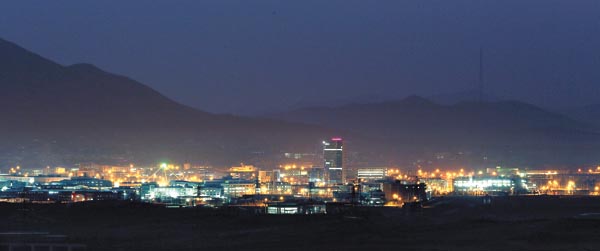Seoul pulls plug on Kaesong park

A panorama of the Kaesong Industrial Complex brightly lit on Dec. 28, 2015. The photo was taken from the Dorasan Observatory in Paju, Gyeonggi. The South Korean government announced on Wednesday that the inter-Korean joint venture will be totally shut down. [KANG JUNG-HYUN]
Unification Minister Hong Yong-pyo announced the plan to totally shut the complex and condemned the North for developing nuclear weapons and missiles despite the disapproval of the rest of the world.
“Continuing the current situation does not merely signify a status quo but can lead to a catastrophic disaster as the North’s nuclear capabilities get enhanced,” the minister said at a press conference Wednesday afternoon, adding that South Korea’s support of the Kaesong Industrial Complex was misused for the development of nuclear weapons and long-range missiles.
“At a time when international society is pushing for sanctions against the North’s nuclear test and long-range missile launch, which violated UN Security Council resolutions on North Korea, we believed there was the necessity for us to take the lead,” Hong said.
The minister said the government concluded the complex could not be operated if it threatens the security of the people, peace on the Korean peninsula and the management activities of companies.
As of November, 124 South Korean companies were running factories in the inter-Korean joint venture employing 54,763 North Korean workers.
A source at the Ministry of Unification said it is completely up to North Korea whether business will ever resume at the complex, hinting that the government will consider a negotiation if the North resolves the world’s concerns over its nuclear weapons and missiles.
The source said the decision was finalized by the National Security Council Wednesday morning, following discussions on sanctions against the North after it conducted its fourth nuclear test in January and the recent long-range missile test.
The ministry had reduced the number of South Korean workers at the complex by 150 to 500 on Sunday.
The unification minister held a meeting with representatives of South Korean companies Wednesday afternoon along with deputy ministers of the Ministry of Strategy and Finance, and the Ministry of Trade, Industry and Energy to explain its shut down plan, including compensation for economic damages related to the pullout.
The South Korean government formed a joint response team to monitor the decision’s impact on markets. The government said it will assure the security of 184 workers who are currently staying at the complex and a minimum number of additional workers who will visit the complex until they entirely end their businesses in the North.
A senior government official said the government is mulling alternative sites for the companies to continue their business but didn’t specify where they are or when they could be ready.
The government sent a notice to North Korea right before the minister announced the plan at a briefing, asking it to cooperate on the safe repatriation of its workers.
The closure would stop about $100 million a year from flowing into the North from the South, mainly the wages of North Korean workers and utility fees. In 2015, $120 million of cash was sent to North Korea, and a total of $560 million in cash has been sent so far from Kaesong.
Unification Minister Hong said that the government and companies have invested more than 1 trillion won so far in the complex and he suspected that North Korea spent some of that money to develop nuclear weapons and long-range missiles.
The announcement came a day after President Park Geun-hye spoke by phone with her U.S. and Japanese counterparts on Tuesday to reaffirm their intention to push the UN Security Council to adopt a resolution with strong sanctions against North Korea.
The Blue House said in a statement on Tuesday that Park and Obama agreed to work for “strong and effective” UN sanctions by the United Nations Security Council and also agreed to push for various sanctions outside the UN.
The Kaesong complex, where nearly 55,000 North Korean laborers receive a minimum of $74 a month in wages, has been a cash cow for Pyongyang, which is ever thirsty for foreign currency.
For the first 11 months of last year, the output of 124 South Korean companies marked $515.4 million worth of goods, surpassing the $500 million mark for the first time since its opening in 2004.
The Kaesong complex is the last of all inter-Korean economic cooperation projects starting during the so-called Sunshine Policy of engaging North Korea. All other projects, such as the Mount Kumgang tour program, have been suspended since 2010, when Seoul imposed economic sanctions to punish Pyongyang for its torpedoing of the Cheonan warship, which left 46 sailors dead. Under the so-called May 24 sanctions, all inter-Korea economic activities except Kaesong have ground to a halt. Pyongyang denies torpedoing of the Cheonan.
The Kaesong joint complex faced crisis in 2013 when North Korea unilaterally withdrew all its workers in protest of Seoul’s policy toward Pyongyang, forcing all work at the complex to stop. It took four months for operations to resume. As a result, output that year plummeted to $223.7 million from $469.5 million in 2012.
The Kaesong complex was created after the first summit between leaders of the two Koreas in June 2000, which also paved the way for holding regular reunions of families separated by the 1950-53 Korean War.
BY KIM SO-HEE [kim.sohee0905@joongang.co.kr]










with the Korea JoongAng Daily
To write comments, please log in to one of the accounts.
Standards Board Policy (0/250자)